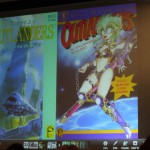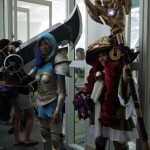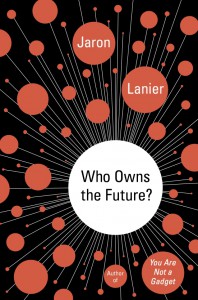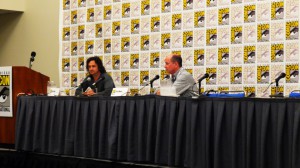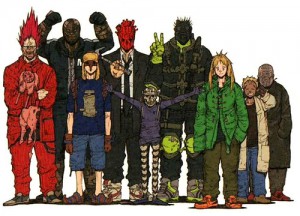The other comics event this July was the Los Angeles Anime Expo, where I spent a glorious few days talking manga with knowledgeable, enthusiastic people, gaping at toys and action figures, and filling in holes in my collection with $1 manga blow-outs. The panels at the Expo were very accessible – no SDCC-level long lines or waiting times. I had the opportunity to talk a bit with Carl Horn, the editor of Dark Horse manga, and with Ed Chavez, publisher, Vertical, both being companies that rock my world with their fantastic titles. When chatting with them, I found out certain things that make me look at the whole business in a different way altogether.
- When I asked them the number of copies they should sell in order to be profitable, for a single volume, the number Carl gave me was 2500, and Ed said 3000. This is a stunningly low number in my opinion, to think that these great stories do not sell that many copies around the world. Yes, both companies have their superstar titles – Vertical had Tezuka’s Buddha and Kirihito; Gundam: The Origin and Chi’s Sweet Home, while DHM has Berserk, Gantz and Blade of the Immortal, among others. But the number of buyers for out-of-the-ordinary titles like Kurosagi Corpse Delivery Service or Twin Spica or Hiroshi Endo’s Eden is painfully low.
- Long-running series are hit the worst, as the number of readers slowly degrade over time and the number of volumes. Dark Horse deals with this by limiting the number of releases of slow-selling titles to one per year, while Vertical refuses to handle long-running series (any series that is beyond 4 or 5 volumes). One exception so far for Vertical is the Gundam: Origin series, which have been pre-order hits. But that is to be explained away by the fact that the Gundam franchise is a juggernaut.
- Picking a new series to license involves a complicated algorithm. Vertical has working relationships with certain Japanese companies such as Tezuka Productions and Kodansha. The latter has its own US publishing arm, after having licensed some of its heavy-hitters to other US companies in the past – Akira to Epic and Dark Horse for example. Vertical’s relationship with others companies like Akita Shoten, Shogakukan and Shueisha is non-existent.
- Kodansha nowadays publishes its popular titles (Attack on Titan, Akira) themselves, and license titles like Drops of God to Vertical.
- Vertical lost money on GTO: The Early Years (or Shonan Junai Gumi) which was the prequel to the best-selling GTO manga published by Tokyopop. The latter went out of business a few years ago, leaving a bunch of licenses high and dry, a great number of titles out-of-print. Vertical picked up GTO Early Years from volume 10 onwards, where Tokyopop had left them unfinished. Sales were dismal, despite a good price-point and titles being released in two-volume omnibuses.
- Most of the Tezuka titles that Vertical has licensed will not be reprinted. This is because of an initiative by the Tezuka estate and the company Digital Manga Publishing, by which DMP owns rights to print all of Tezuka’s oeuvre in English digitally. Titles such as Black Jack and Princess Knight are already going out of print.
- Vertical has tri-annual reader polls on what titles they should license from Japan. They have some conditions about which books they cannot publish – anything before 2000, no long series, no Go Nagai books, and no novels, because they have a long list of novels already. (They published Takeshi Kitano’s A Guru is Born, and Koji Suzuki’s Edge, which won the Shirley Jackson award this year)
- Dark Horse seems more focused on franchises that worked out well already, and creators associated with those franchises. They are about to publish Shin Kozure Okami, the sequel to Lone Wolf and Cub, along with more books by Clamp, Yashuhiro Nightow and Yoshitaka Amano. Titles such as Lone Wolf and Trigun are being rereleased in omnibus format.
- Long running DHP titles such as Blade of the Immortal and Gantz end soon, and it will be interesting to see what takes their place.
- Both Carl and Ed are very disappointed with the titles that did not work out. Twin Spica was licensed because it was a huge success in Japan, but fared much worse than Seven Billion Needles. The wine-themed Drops of God is a bestseller in France and Japan, but lost a lot of readers by volume 4, making it unfeasible to publish (it is up to 25+ volumes in France). Dark Horse could not complete the five-volume Satsuma Gishiden by Hiroshi Hirata, and Eden has been on hiatus for a long time (after 13 volumes published out of 18) despite getting rave reviews initially. Blood Blockade Battlefront, by Trigun creator Yashuhiro Nightow isn’t selling as expected either.
- Despite all this, there is a manga resurgence of sorts. More and more people are reading manga, and Josei titles like Utsubora and Moyoco Anno’s Sakuran are making their way to fans and readers.
The high-point of AX was getting to meet director Makoto Shinkai, director of Five Centimeters Per Second and The Garden of Words. Shinkai-san is much younger than I thought, and the line for his signing went around four corners of the gigantic lounge. A lesser person would have capped the line when he saw the crowd and that there were 20 minutes remaining, but Shinkai-san blazed through the line, saying “we can do it!”. I got my copy of the Five Centimeters manga signed. It was published by Vertical, but you knew that already, didn’t you?


